What is Omnichannel Retail? A Guide to the Lastest Trends & Examples
- February 12, 2024
- 16 mins read
- Listen

Shopping today often spans more than one channel. Brick-and-mortar stores are no longer the only option people use to buy things. They often use online channels as well like websites, stores, and social media. In fact, 73% of consumers use multiple channels during their shopping journey. (Harvard Business Review).
With this drastic change in shopping behavior, do retailers – who continue to rely on a single-channel retail strategy – stand any chance?
Now when omnichannel has become a baseline expectation, traditional retail can’t survive unless it changes the way. This is where omnichannel retail can help.
Omnichannel retailing is the way forward because conventional retail strategies can’t provide the kind of cohesive and personalized shopping experiences consumers expect across all channels. More importantly, omnichannel retail can seamlessly blend various channels into one and ensure a consistent and unified shopping experience.
In this blog, we will discuss omnichannel retailing in detail, understand its benefits, examples, and trends, and also learn how to devise a strategy.
Before we dig deep, let’s understand the concept better through definition….
What is Omnichannel Retail?
Omnichannel retail is a fully integrated approach to commerce involving multiple transaction channels such as physical stores, marketplaces, social channels, and more. It’s a strategic approach to providing shoppers with a unified experience across all channels or customer touchpoints. This form of retailing is helpful for merchants to reach customers where they want to buy products.
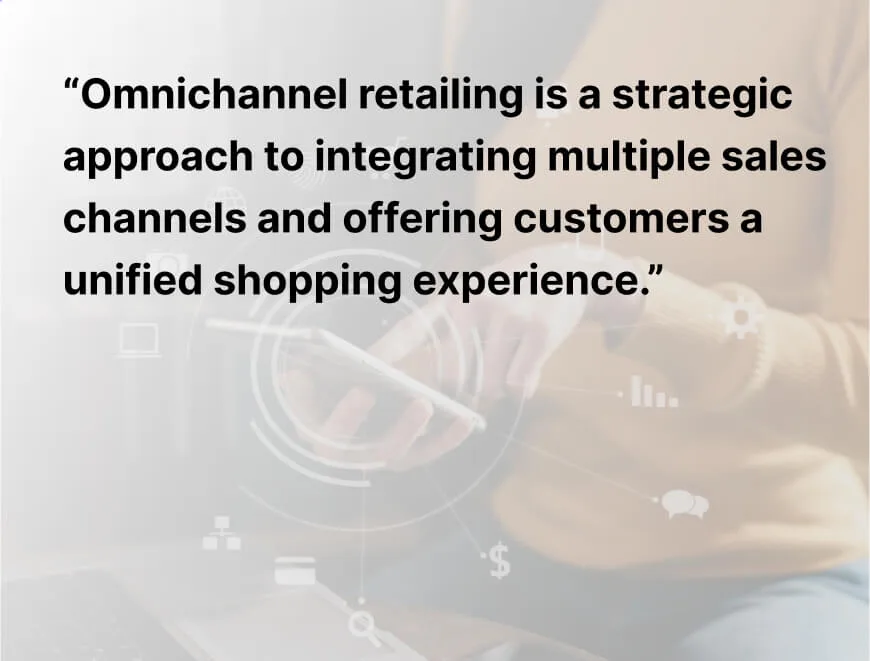
Retailers can use an omnichannel strategy to effectively engage customers through multiple digital and physical touchpoints. With more than 60% of consumers participating in omnichannel shopping, retailers have no option but to create a consistent and on-brand experience from start to finish. This form of retailing integrates all touchpoints into a holistic omnichannel approach to align with the changing shopping needs of consumers.
Omnichannel retailing is –
- To offer the customer exactly what they need, when they need it, and where they need it, regardless of the channel and device they use
- To blend both the digital and physical worlds simultaneously to enhance the shopping experiences at each touchpoint
- To give customers the flexibility to switch between channels seamlessly while shopping and get a cohesive experience
Omnichannel Retail vs Multichannel Retail: Key Differences
|
Omnichannel Retail |
Multichannel Retail |
|
A more customer-focused approach to retailing |
A more product-focused approach to retailing |
|
It integrates all channels and touchpoints so that they work together |
It does not integrate all channels and touchpoints |
|
New and memorable customer experiences are created by combining different channels |
Customer experience is limited to the capability of each channel |
|
Builds upon interactions on other channels to deliver unique content or experience at each touchpoint |
Doesn’t blend customer interactions across channels, so fails to deliver unique content or experience at each touchpoint |
Benefits of Omnichannel Retail
Meet the Expectations of New-Age Shoppers
Customers today are no longer satisfied with just one channel for shopping. They want to shop anytime, anywhere, and on the channel of their choice. The need is growing for consistent shopping experiences across touchpoints, whether shoppers browse products online, visit a brick-and-mortar store, or purchase through mobile apps. So, retailers can switch to an omnichannel strategy and let shopping experiences align with the preferences and expectations of new-age buyers.
Connect with Customers on Any Channels
Gone are the days when shoppers had just one channel to shop: physical stores. Today, they have multiple channels to collect information, browse & compare products, and then make purchases. This change in buying behavior has also helped retailers who can now target and connect customers on multiple channels. Merchants can allow shoppers access to product information across all touchpoints and channels.
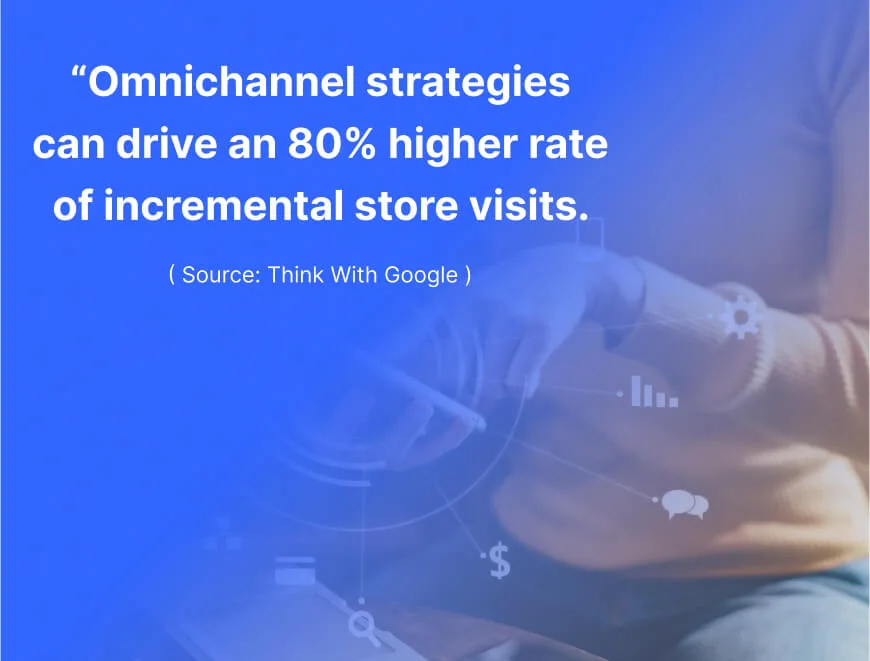
Use Customer Data to Personalize CX
80% of customers are more likely to make a purchase when brands provide them with personalized experiences. But the question is – how can a merchant personalize the shopping experience? The answer is – by understanding the needs and preferences of buyers. Omnichannel retail provides you with key customer information including past purchase history, search preferences, demographics, and more. This information can prove helpful in tailoring the shopping experience accordingly.
Create More Opportunities for Sell
Omnichannel retailing helps merchants reach more customers across multiple channels. With more customers to target, it can increase the chances of sell. Omnichannel strategies can drive an 80% higher rate of incremental store visits. ( Think With Google ). Giving customers more avenues to shop, and giving them flexibility to switch between channels can encourage them to buy, resulting in more YOY sales for your business.
Increase Your Customer Retention Rates
Implementing a robust omnichannel strategy is key to allowing customers to shop anywhere. This flexibility inspires customers to buy more and spend more. Companies that implement omnichannel customer engagement strategies achieve 91% more year-over-year customer retention rates. (Loyalty360.org). What’s more, this form of retailing also increases loyalty, resulting in improved retention rates over time.
How to Build an Omnichannel Retail Strategy – A Step-by-Step Guide
1. Understand Where Your Customers Shop
A successful omnichannel retail strategy requires two things –
- Understand your customers
- Understand where your customers shop
Market research will help you understand your customers better. It will help you understand the preferences and behaviors of your target audience. The research is key to collecting data on your audience’s demographics.
Once you know your customers, the next step is to make a presence where your customers are. Rather than using multiple channels simultaneously, focus on only those where your customers shop.
Since customers may use multiple channels to shop, you need to find out how those channels overlap. This information is essential to delivering a branded and seamless experience.
As an omnichannel retailer, you need to focus on the touchpoints, channels, and devices being used by your target customers. You can then create cross-channel campaigns, build awareness, and drive conversion rates.
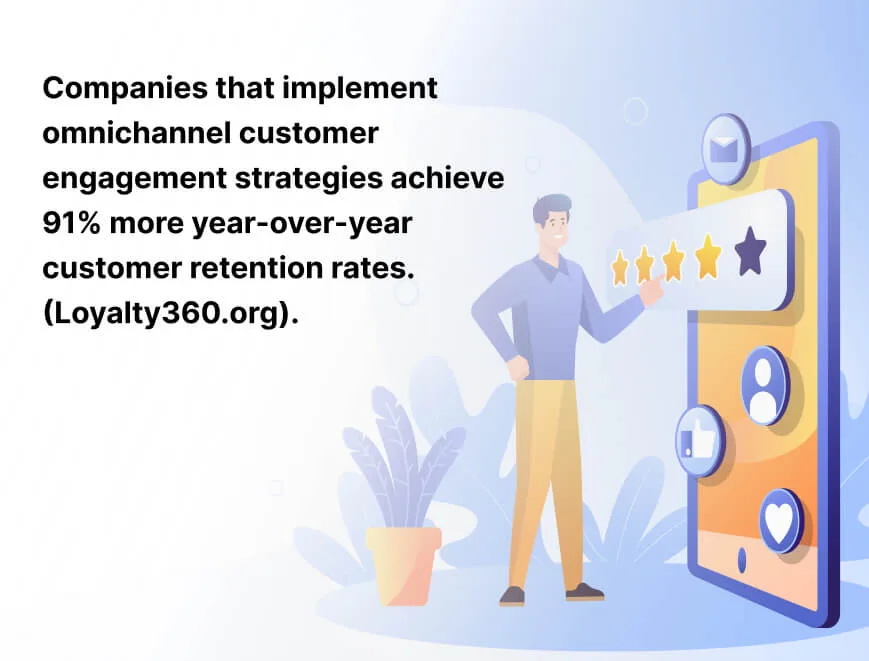
2. Create a Customer Journey Map
What next once you understand your customers and know where they shop? The next step is to create a customer journey map – it will help you find the rationale behind a customer’s decisions and experiences.
A customer journey map is key to analyzing all the “HOWs” and “WHYs’ behind the method of your customer’s madness ( i.e. shopping patterns and behavior ).
This map will help you track three key things –
- Touchpoints – You can track all the interactions that customers have with your brand, whether they happen via the website, live chat, mobile app, social media, etc.
- Pain points – Analyzing the journey map will help you know the gaps that still exist in the customer experience.
- Actions – The map will tell you the reasons/ sentiments that may have caused customers to switch elsewhere rather than buy from you.
3. Maintain Consistency in Branding Across All Channels
While omnichannel retailing is about integrating different channels and touchpoints, it doesn’t mean offering a disjointed experience to customers. The key is to maintain consistency across all channels whether customers shop via the website or social media platforms.
To maintain consistency in branding –
- Make sure you maintain consistent messaging and aesthetics, be it through your app, online, or in-store.
- Ensure your brand maintains the same vibe across channels so that customer experience is enhanced
To achieve this goal, all your customer touchpoints should align with your overall branding ethos. Every aspect of your business should reflect your brand philosophy irrespective of the channel you use to engage and interact with your audience.
4. Provide Cross-Channel Customer Support
Customers feel frustrated and disappointed when they have an issue but there is nobody to help them out. Such customers don’t think twice before moving on to the next retailer.
Would you like to lose a customer for that small a reason?
Well, you should not. That’s why when you create an omnichannel retail strategy, your ultimate goal should be to help each customer out. To achieve this goal, you need to implement a cross-channel customer support system.
This system will be useful in helping customers no matter on which channel they shop, or where they stand on their customer journey.
When support is available across channels, customers feel encouraged to buy. On the other hand, if there is no support system on any channel, it might lead to missed opportunities for your business.
A successful omnichannel retail strategy puts customer support at the center of all activities. Doing this can help you provide the kind of support your customer looks for on every channel.
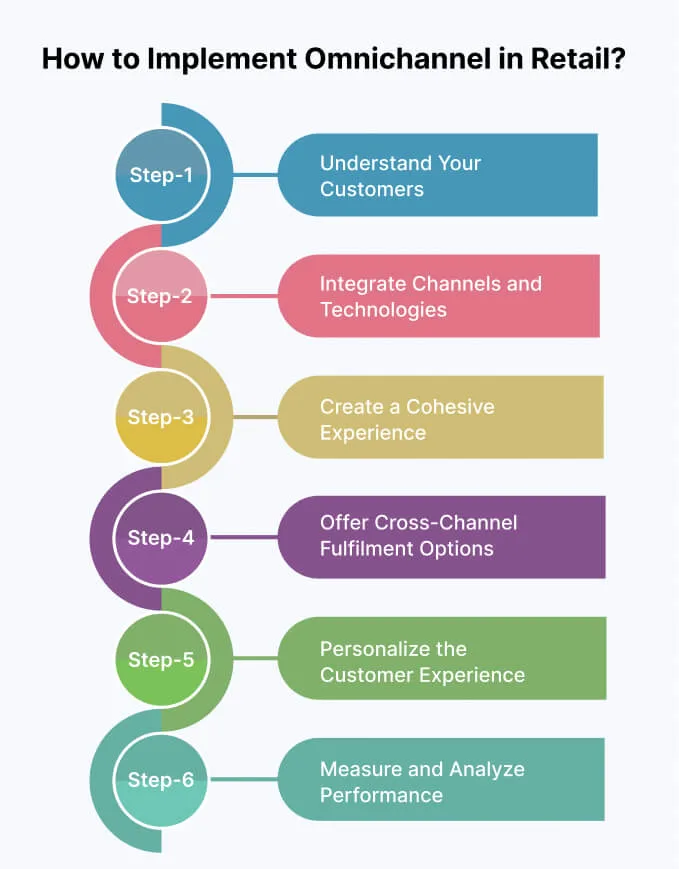
5. Integrate Your Technology
Selling on multiple channels is a big challenge for any retailer. The problems compound when the retailer does not closely integrate its tech stacks. Inventory management is the biggest issue faced by retailers when they implement an omnichannel strategy.
If the tech stack is not integrated, a retailer may fail to have a unified view of the available inventory. When real-time inventory data is not available across channels, it can leave the omnichannel tactic far less effective than it should.
To integrate your technology, consider these strategies –
- Consider investing in an omnichannel retail software solution
- Integrate customer data and fulfillment options for customers
- Use a data feed management service to unify your data across touchpoints and channels
6. Offer Cross-Channel Fulfillment Options
An effective omnichannel retail strategy allows customers to seamlessly move through channels and also shop without any hassle. This can’t happen unless you enable cross-fulfillment options. You also need to align all touchpoints so that a customer can buy from any channel of choice.
To offer cross-fulfillment options, you should ensure that customers can buy online directly from the store, visit and pick in-store, get items shipped from the store, have same-day delivery, and so on. It’s equally important to give customers real-time data on inventory availability across all channels so that they can make choices.
7. Complement Your Retailing with Automation
Running an omnichannel retail business means having to face tons of repeatable processes that you can easily automate and add efficiency to your entire operations. These processes are often not high-value in nature and support teams can avoid them and focus on more complex tasks.
To implement automation, you can use a chatbot on your online store and answer routine queries of customers efficiently. You can also invest in a tech stack that lets you have a real-time view of your business and make data-driven decisions quickly.
In addition, you can set up behavioral triggers to deliver the right messages to customers at the right times. Many retailers already use automated welcome and follow-up messages to add to customer experience before and after purchase.
Examples of Omnichannel in Retail
Starbucks
Starbucks – the coffee giant – is among those revered retailers that often get their omnichannel strategy bang on target. This is one key reason why coffee aficionados all over the world love it so much and line up for a hot cuppa anytime of the day. The kind of integrated experiences it provides often add up to the joy of drinking coffee at a favorite retail outlet. Every time a user pays with a Starbucks card, he/she accumulates reward points that get added up. Its App helps users find stores near them and order drinks well before reaching the outlet in person.
Sephora
Sephora is a skincare retail giant that stands out for its great practices of omnichannel retail. The company uses various channels – such as mobile apps, websites, physical stores, and social media platforms – to take its products to customers. Its loyalty program, Beauty Insider, is the real differentiator – a free-to-join program that lets shoppers track their purchases and get the right beauty products. A customer can shop its products on any channel of choice and may visit the store if he/she feels like it. All this boosts customer engagement to a great level.
Amazon
When it comes to omnichannel retailing, Amazon not only sets the standards but also inspires other brands to emulate its great feats. Customer data is the main source that fuels its omnichannel strategy and ensures value to customers across channels. The company connects this data across channels to provide the kind of personalized shopping experience customers covet. Its paid loyalty program – Amazon Prime – is the real deal for customers as it offers them free and fast shipping, together with other benefits. This loyalty program brings tons of customer data that it uses to offer a cohesive shopping experience to customers.
Value City Furniture
When customers buy furniture, they want both – the convenience of online shopping and the product feel of offline. Value City Furniture is among the first retailers in this space to realize this need and find a solution. So, it has designed an omnichannel system to cater to customers looking for a “test drive” of furniture before buying it. Now, customers can use its online store to build a shopping list and then visit the physical store to view the furniture in real life. This strategy has worked wonders for the company, boosting shopping engagement and sales.
Omnichannel Retail Trends
Social Ecommerce to Become More Interactive
More and more people now follow brands on social media. They not only follow but also engage and buy. Social commerce has been rising in scale in the last decade and the trend is not going to stop. However, as customers evolve, they expect social commerce to turn more interactive for them. Retailers therefore need to focus on minimizing the friction between discovery and conversion. This is why we witness more emphasis on social marketing and promotion by merchants these days.
Shopatainment to Gain More Focus
Selling should be fun. This is what new-age customers feel. Merchants realize this change in attitude, so they are making sales as fun as possible. This is why shopatainment is rising in trend – it’s a form of live social selling where video is predominantly used to engage and drive conversions. Quality and entertaining videos replace product photos and this enhances engagement for buyers. Many retailers now use Instagram Live to sell products in real-time, and customers are lapping it up with open arms.
AR and VR Technologies to Get More Focus
Retailers today provide more visual tours of their stores to customers. They ensure more interactive product demos and more virtual try-ons. Why is all this happening? Well, customers these days have high expectations and they want a shopping experience that is highly interactive and immersive. This is why merchants look to integrate Virtual Reality (VR) and Augmented Reality (AR) technologies in various aspects of the operation to stay aligned with the changing demands of customers.
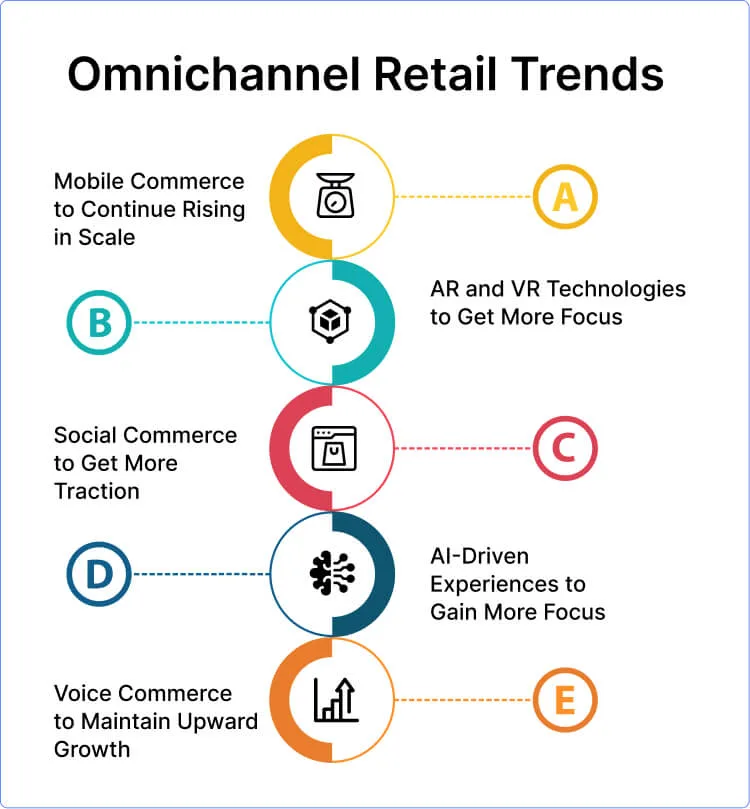
AI-Driven Experiences to Drive More Buyer Engagement
Personalization is the buzzword today. More retailers want to provide tailored experiences as they know it has a massive impact on conversion. Thanks to the rapid advancements and emerging trends in AI and Machine Learning, offering personalized experiences has become easier than before. This is also why more retailers look to offer targeted customer experiences. Using chatbots and live chat software on the website or stores and leveraging data analytics are key aspects that are driving personalized experiences across channels.
Voice Commerce to Continue its Popularity
Voice-activated shopping is not only growing at a phenomenal rate but also touching the sky. Most merchants realize its huge potential and craze among millennials in general. This is why voice commerce features now are central to retail omnichannel strategies. These days, merchants focus on optimizing every aspect of the business for voice search, be it their product listings or checkout processes, and the trend is going to continue forever.
Final Thoughts
Customers are evolving, and so their expectations with shopping. Retail omnichannel is the reflection of modern times and how customers like the freedom to switch between channels.
At REVE Chat, we understand how engagement is at the core of an effective omnichannel retail strategy. That’s why we offer a variety of tools for businesses to engage with their customers better and deliver them the kind of experiences they covet.
Your business can use our AI-powered chatbot to automate tasks across sales, marketing, and support. We also have video chat software, co-browsing software, and a ticketing system to enhance engagement-based workflow.
It’s also possible to add live chat and chatbot together to deliver hybrid support experiences to customers.
With us, you can sign up and check how our tools can add great value to your omnichannel retail model.
Frequently Asked Questions ( FAQs)
1. What Does Omni Channel Mean in Retail?
Omnichannel in retail is an approach of blending the advantages of both offline and online modes together to deliver a superior customer experience. It’s a retail model where the convenience of online buying merges with the essence of in-store shopping so that customers can enjoy the best of both worlds together. Omnichannel in retail gives customers the flexibility to interact with multiple sales and media channels, and also move between channels in one seamless journey.
2. What are the Benefits of Omnichannel Retailing?
Omnichannel retailing provides many benefits to merchants, including –
- Integration of various digital touchpoints
- Giving a unified and cohesive experience to shoppers
- Providing more channels for customer purchase
3. What is the Omni Channel Strategy?
In retail and ecommerce, omnichannel is a term or concept that is used for the strategy of integrating multiple channels together to deliver a seamless shopping experience. It’s a unique retail method that opens up more channels and more sales opportunities for merchants.
4. What are the Objectives of Omnichannel Retail?
The main objectives of omnichannel retail include –
- To elevate shopping experiences for buyers
- To deliver a positive and consistent shopping experience on each channel
- To provide customers multiple channels to engage and buy from a brand
- To offer personalized shopping experiences to customers
5. What is an Example of a Brand that Successfully Uses Omnichannel Retailing?
Amazon is a good example of a brand that successfully uses an omnichannel retail strategy. It uses customer data to personalize experiences. It runs a loyalty program, Amazon Prime, that fetches it lots of customer data for tailoring experiences across channels and devices.




